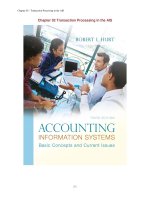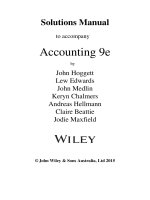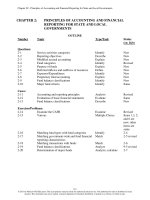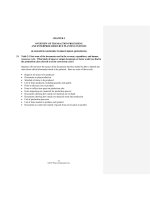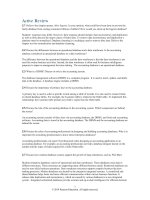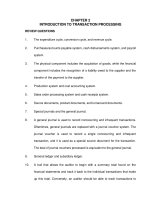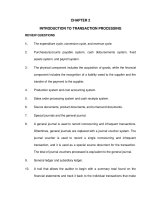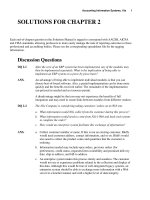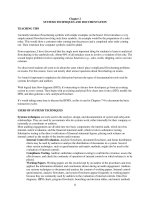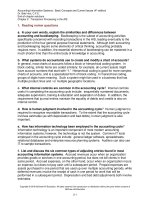Test bank and solution of accounting informations for business decision (1)
Bạn đang xem bản rút gọn của tài liệu. Xem và tải ngay bản đầy đủ của tài liệu tại đây (446.67 KB, 68 trang )
Information for Business Decisions
SOLUTIONS MANUAL
Billie M Cunningham Loren A Nikolai John D Bazley
Marie Kavanagh Geoff Slaughter Sharelle Simmons
Cunningham 1e Accounting: Information for Business Decisions Solutions Manual
Chapter 1
Introduction to business, accounting
and the role of professional skills
The questions in this chapter are divided into three sections:
• Testing your knowledge: these questions are straightforward and are designed to help
students assess their basic knowledge of a particular topic.
• Applying your knowledge: these questions ask students to use their basic knowledge to
solve a particular problem.
• Making evaluations: these questions are more complex and ask students to integrate
their knowledge of a particular topic or topics to make decisions.
We have included the ‘Content analysis’ below to help instructors decide which applying
your knowledge questions to assign. It briefly summarises the content of each question.
We did not provide a content analysis for the making evaluations questions because of
their lack of uniformity, and because of the multiple topics included in them.
Content analysis for applying your knowledge questions
1.28 Service and Manufacturing Businesses. Explain how two businesses are examples
of a service business and a manufacturing business.
1.29 Cash Flows. Explain how knowledge of a business’s cash receipts and payments
would help a bank make a loan decision. Determine which financial statement the
bank would request for help making the decision.
1.30 Business Organisation. List factors involved in deciding whether to operate as a sole
proprietorship, a partnership, or a business.
1.31 Business Location. List questions a business should ask before opening a factory in
a new location.
1.32 International Business Location. Referring to 1.31, list questions a business should
ask before opening an international branch. Compare questions with 1.31.
1.33 Internal and External Users. List examples of business information useful to both
internal and external users.
1.34 Management Information. Give examples of information that would be useful in the
management activities of planning, operating, and evaluating.
1.35 GAAP. Explain what generally accepted accounting principles means and how they
affect business reports. Explain why new proposals would concern business owners.
1.36 Financial statements. Describe financial statements, list the major financial
statements, and explain what each financial statement includes.
© 2012 Cengage Learning Australia
Cunningham 1e Accounting: Information for Business Decisions Solutions Manual
1.37 Ethics. Explain how codes of ethics help businesspeople make decisions.
1.38 Forming Arguments. Consider two sides of an issue and develop arguments to
support both sides.
1.39 Argument Presentation. Develop alternative methods for presenting an argument to
a boss while considering possible rebuttals from the boss.
1.40 Evaluating Opportunities. Develop questions to ask a boss concerning a new job
offer.
1.41 Evaluating Loan Customers. Determine what information is needed to evaluate a
loan applicant and how this information could affect the loan decision.
1.42 Evaluating Accounting Information. Referring to 1.41, determine what could be
added to accounting information to make it more useful in the loan decision.
1.43 Critical Thinking and Problem Solving. Develop a list of ideas to solve an office
problem.
1.44 Logical Application of Knowledge and Reasoning. Determine the flaw in a coworker’s reasoning.
© 2012 Cengage Learning Australia
Cunningham 1e Accounting: Information for Business Decisions Solutions Manual
Testing your knowledge
1.1
Private enterprise refers to an economic system in which individuals, rather than
government, own and operate businesses.
1.2
A service business is different from a manufacturing or merchandising business
because it sells services, rather than goods or physical products to customers.
1.3
Both merchandising and manufacturing businesses sell products to their customers.
The difference between the two is that a manufacturing business makes the products it
sells. A merchandising business buys products that are ready to be sold (often from a
manufacturing business) and then sells those products to its customers.
1.4
Entrepreneurship refers to a situation in which an individual with an idea for a business
willingly risks the loss of both time and money to obtain capital to use in the production
and sale of goods or services.
1.5
As an entrepreneur in need of resources, you might go to a bank for a loan or invest
your own money. If you need equipment, machinery, or furniture, you might finance the
purchase of these items through the seller or lease them. Entrepreneurs also can
obtain capital from individuals who have money to invest.
1.6
The first factor affecting the business environment is easy access to a vast amount of
information which allows businesses to make decisions using timely information. The
only drawback is that managers must be able to sort through the information to find
that which is most relevant and timely.
The second factor is technological advancement. Technology has extended the
work day and allowed quick communication over vast distances. It also has allowed
access to up-to-date information and enabled production lines to work without human
intervention. This development has made the world more competitive.
The third factor affecting the business environment is the globalisation of business
activities. Globalisation creates a larger, more diverse marketplace. The challenge is to
market the same product to different cultures using different languages and currencies.
The fourth factor is the increasing number of regulations which a business must
follow. As a business chooses to operate in different countries, the number of
regulations that it must follow may increase. Businesses may be affected by politically
arranged, economic, or trade agreements between countries.
© 2012 Cengage Learning Australia
Cunningham 1e Accounting: Information for Business Decisions Solutions Manual
The fifth factor is the many different ways to conduct business. The numerous
different types of business transactions affect the business environment by allowing
businesses alternative ways to finance activities, invest cash, and compensate
employees. E-commerce allows businesses to conduct business with other businesses
and consumers more conveniently than in the past.
The sixth factor is the many different ways in which businesses can be formed. The
changing forms of business allow owners to choose an organisational form (each with
unique advantages and disadvantages) that most closely meets the needs of the
business.
1.7
A business organised as a company is considered a separate legal entity, which
means that it can own property, enter into contracts, issue stock, and be taxed. Neither
sole proprietorships nor partnerships are considered legal entities. The result is that
when these types of businesses have property, it is considered the property of the
individual owners. Any profits earned by a sole proprietorship or partnership are
considered income of the individual owners who must pay the income tax on those
profits. Additionally, the individual owners of these types of business organisations are
liable for any debts of the business.
1.8
There are four types of regulations with which a business must comply. Those
regulations may change depending on where the business chooses to operate.
Local regulations are those set by either the city or council in which the business
operates. Local regulations may include pollution control measures, health permits,
and zoning regulations. Because these regulations are created by city and local
authorities, there may be differences between different cities or counties in the same
state.
State regulations, as the name indicates, are those set by state governments. Many
state regulations require businesses to pay state income taxes, franchise taxes, and
state unemployment taxes. State regulations also can require businesses to collect
different taxes e.g. sales tax. States also regulate the types of businesses that can
operate in the state and the licensing of professionals. State regulations can vary from
state to state.
Federal regulations apply to businesses regardless of where in the country they
choose to operate. For example, businesses must comply with Australian Taxation
Office (ATO) rules of paying income taxes, and all business withhold federal income
taxes from employee's pay and pay goods and services (GST) tax. There are also
regulations monitoring safety, competition, and workplace discrimination.
If a business chooses to operate outside of its home country, it also must abide by
the laws and regulations of the country in which it chooses to operate.
© 2012 Cengage Learning Australia
Cunningham 1e Accounting: Information for Business Decisions Solutions Manual
1.9
Accounting is a system of recording and reporting economic information about the
resources and activities of a particular entity and conveying that information to
interested parties.
1.10 Both management accounting and financial accounting use accounting information to
generate reports about the resources and activities of a business. These reports help
communicate information to users to help in decision-making.
The main difference between management accounting and financial accounting is
the intended users and their different information needs. Management accounting
focuses on users within the business (managers) and helps them with their planning,
operating and evaluating activities. Financial accounting focuses on users external to
the business (investors/stockholders and creditors) and helps them decide whether or
not to engage in some activity with the business.
1.11 Management accounting reports help managers in planning activities by identifying the
activities and resources needed to achieve the goals of the business. These reports
also can help managers analyse planned activities and alternative actions by providing
revenue and cost estimates.
Management accounting reports help managers in operating activities by providing
timely economic information about how alternative actions will affect the profit and
solvency of the business. Managers use this information to make day-to-day decisions
about which activities will best achieve the goals of the business.
Management accounting reports also help managers in evaluating activities.
Managers use revenue and cost estimates generated in the planning process as a
benchmark and then compare actual revenues and costs against that benchmark.
1.12 Generally accepted accounting principles (GAAP) are a set of principles, procedures,
and practices that businesses use for financial accounting and reporting. These ‘rules’
are developed by professional organisations and all accountants are required to follow
the ‘rules’ when maintaining books of account for a business.
1.13 Financial accounting reports help external users by revealing information about a
business's ability to generate cash to pay its bills, and about a business's ability to
earn a profit. This information helps external users such as creditors and investors
analyse a business's potential credit risk and possible return on investment.
1.14 Today's business environment is one in which many people face complicated ethical
situations where the distinction between wrong and right is not clear. Business groups
have established ethical codes to help members work through difficult issues. Ethical
© 2012 Cengage Learning Australia
Cunningham 1e Accounting: Information for Business Decisions Solutions Manual
codes also help reassure the public that the work done by members of the group is
performed in an ethical environment and is reliable.
1.15 A sustainable business is one that is strategic and makes sure that all processes,
products and activities, while generating a profit, address concerns about corporate
social responsibility and environmental management. Business sustainability refers to
the fact that the business must operate efficiently and productively in order to remain
profitable and allow the business to grow.
1.16 Internal control involves the procedures needed to control, or minimise, a business’s
risks (of losses, earnings drops, fraud, fines, scandal, and so forth), to safeguard a
business’ economic resources, and to promote the efficient and effective operation of
its accounting system.
1.17 In order to be prepared to enter the profession of accountancy, a graduate needs a set
of skills to apply the accounting knowledge learned. These skills include the abilities to
communicate, to perform research, to analyse and organise information, to understand
and apply knowledge from diverse areas, and to use judgment. In addition, employers
and professional bodies recommend that these individuals possess functional,
personal, and broad business perspective competencies. Functional competencies
relate to the technical competencies, which are most closely aligned with the value
contributed by accounting professionals i.e. knowledge and ability to apply skills.
Personal competencies relate to the attitudes and behaviours of individuals preparing
to enter the accounting profession such as self management. Developing these
personal competencies will enhance the way professional relationships are handled
and facilitate individual learning and personal improvement. Broad business
perspective competencies relate to the context in which accounting professionals
perform their services. Individuals preparing to enter the accounting profession should
consider both the internal and external business environments and how their
interactions determine success or failure. They must be conversant with the overall
realities of the business environment.
1.18 Auditing is a part of a business's control procedures. Internal audits review the
business's operations to ensure that all employees are following the required
procedures. External audits are conducted annually to ensure the business is
complying with GAAP in accordance with accounting standards. Auditing involves the
examination, by an independent CPA, of a business's accounting records and financial
statements, and the business’s internal control over its financial reporting. Based upon
the sample evidence gathered in the auditing process, the CPA expresses a
professional, unbiased opinion about (or attests to) the fairness of the accounting
© 2012 Cengage Learning Australia
Cunningham 1e Accounting: Information for Business Decisions Solutions Manual
information in the business's financial statements and the effectiveness of the
business’s internal controls.
1.19 Three professional organisations of accountants exist in Australia including the
Institute of Chartered Accountants (ICA), the Certified Practising Accountants (CPA),
the National Institute of Accountants (NIA). Similar organisations exist in New Zealand
including the New Zealand Institute of Chartered Accountants (NZICA).
1.20 The business environment is constantly evolving due to the changing factors that
affect it. Some example of factors not mentioned in the chapter are as follows:
• The ATM card is an example of a technological innovation that has affected the
business environment. ATM cards have effectively extended banking hours and
may eventually replace cash and checks as a widely used form of payment.
• The change in televisions from analogue to digital is an example of a technological
innovation which may affect the business environment in the future. This innovation
may allow TVs to function as computers which would increase accessibility to
computers, and allow more people the option of telecommuting.
• The increase in the minimum wage is an example of a regulation that will affect the
business environment. The increase may affect selling prices as businesses try to
compensate for the increase in labour costs.
• The mapping of human genes is an example of a discovery that may affect the
business environment. Some people fear that this type of information may lead to a
new type of hiring discrimination. People with a genetic predisposition for certain
diseases may find it difficult to find and keep jobs. The result may be an increase in
unemployment or an increase in the number of entrepreneurs and small
businesses. On the other hand, this knowledge of genes might eliminate some
illnesses, or allow physicians to recognise illnesses earlier than in the past, perhaps
generating higher cure rates. This would result in a healthier workforce and lower
health-related costs for businesses.
• A unique example of a discovery (technological innovation) that may affect the
business environment is the use of animals to produce drugs. For example, some
genetically altered goats are being used to produce protein drugs. The drugs come
from the goat milk and are harvested more cheaply than traditional laboratory
methods. This discovery/innovation will lower drug business costs and the prices of
many expensive treatments of serious diseases. This discovery/innovation will also
make ‘farming’ a more profitable and attractive career.
1.21 The broad skills necessary for practicing accountancy and effectively conducting
business are:
© 2012 Cengage Learning Australia
Cunningham 1e Accounting: Information for Business Decisions Solutions Manual
• communication skills (written and verbal),
• interpersonal skills (including the abilities to lead and influence others, to motivate
others, to withstand and resolve conflict, and to organise and delegate tasks),
• intellectual skills (creative and critical thinking), and
• a knowledge base necessary to support intellectual skills (including general
knowledge, organisational and business knowledge, and accounting and auditing
knowledge).
1.22 There is a difference between thinking and critical thinking. Thinking is a natural
function for human beings. Critical thinking, however, requires practice as well as an
awareness and monitoring of the thought process. A critical thinker must be aware of
the assumptions made and be able to judge whether there is sufficient evidence to
support those assumptions. A critical thinker also must be aware of his or her own
biases and be able to keep those biases from affecting the thought process.
1.23 Independence refers to the critical thinker's use of others beliefs and ideas. To be
independent, the critical thinker does not accept the beliefs of others without
questioning the source of those beliefs and the evidence supporting them.
Objectivity, refers to the critical thinker's own beliefs and ideas. To be objective, the
critical thinker must be aware of his or her own biases and prejudices and try to
eliminate them from his or her thinking when evaluating ideas.
© 2012 Cengage Learning Australia
Cunningham 1e Accounting: Information for Business Decisions Solutions Manual
1.24 It is important to evaluate the credibility of a source of information because of the
possibility that the information is faulty or biased. If the source is not credible, what is
the probability that the information is good? The credibility of information sources must
be evaluated to ensure that decisions are made based on accurate information.
1.25 Because general knowledge encompasses knowledge of history and of various
cultures, it provides a vast background that may help critical thinkers evaluate ideas
and make value judgements about solutions. It also helps critical thinkers ‘see’ other
points of view.
Organisational and business knowledge includes knowledge of how businesses
work and of how various factors affect businesses. This knowledge helps creative
thinkers develop ideas and implement them in a particular business environment. It
also helps critical thinkers evaluate alternatives and better understand the effects of
solutionsto problems.
1.26 The first stage of problem-solving is recognising and defining the problem. In this
stage, the problem solver defines the problem, gathers facts surrounding the problem,
and identifies the objectives that would be achieved by solving the problem. The major
pitfall in this stage is the possibility of incorrectly identifying the problem. Solving the
wrong problem could lead to new problems, make the problem worse, and lead to an
unproductive course of action.
The second stage is identifying alternative solutions. In this stage, the problem
solver uses both creative and critical thinking to generate and identify workable
solutions. A pitfall that the problem solver might encounter in this stage would be an
inability to arrive at solutions that are workable. If the problem is not defined clearly, it
may be difficult for the problem solver to determine which solutions fit the criteria or
solve the posed problem.
The third stage is weighing the advantages and disadvantages of each solution. In
this stage, the problem solver evaluates potential solutions by examining the different
effects of each. A pitfall that might be encountered in this stage could be an incorrect
understanding of the effects of potential solutions. This could occur if the information
used is interpreted incorrectly or if a solution is formulated based on incorrect
information. Also, if the problem solver relies on numbers alone, he or she may not
identify some of the more subtle advantages or disadvantages of the proposed
solutions.
The fourth and final stage is choosing a solution. In this stage the problem solver
looks at the evaluation of advantages and disadvantages from the previous stage and
decides the best course of action. A pitfall the problem solver may encounter in this
stage is the choice of a solution which does not solve the problem or which is not the
© 2012 Cengage Learning Australia
Cunningham 1e Accounting: Information for Business Decisions Solutions Manual
‘best’ solution. This pitfall could occur in a number of different circumstances. This
could occur if the problem solver misunderstands the criteria necessary to solve the
problem, if the circumstances surrounding the problem change during the process of
finding a solution (the defined problem and the criteria for solving it may no longer be
valid), or if the problem solver has a difficult time comparing the advantages and
disadvantages of each solution (due to the different weights of each).
The pitfalls for each stage can be interrelated. For example, if the problem solver
misidentifies the problem in stage one, the actions of each stage will be affected. Also,
if the problem solver quits too soon in stage two, it is possible that the best solution will
never be identified. Finally, however thorough the problem solver is, unanticipated
future events may cause the chosen solution not to work.
1.27 Accounting information is used in each stage of problem solving. In the first stage,
accounting information (information on costs, pricing, etc.) is examined to help identify
the problem. In the second stage, accounting information can be used to determine
whether or not potential solutions are workable (if we have already borrowed as much
as we can, are there other sources of cash?). In the third stage, accounting information
is used to determine the economic effects of each solution including determination of
costs, profits, timing of cash receipts and payments, and effects on income taxes. In
the fourth stage, the problem solver uses accounting information specified for each
solution in stage three and decides, based on that information, which solution will be
the best (which solution provides the greatest benefit at the least cost).
© 2012 Cengage Learning Australia
Cunningham 1e Accounting: Information for Business Decisions Solutions Manual
Applying your knowledge
1.28 When you buy a ticket from Qantas Airlines, you are purchasing the right to sit on an
airplane as it travels from one place to another. You are buying transportation.
Because transportation is something intangible, it is considered to be a service.
Because Qantas Airlines is in the business of providing transportation (the peanuts are
incidental), it is considered to be a service business.
When you visit your local Toyota dealer to purchase a car, you also are buying
transportation. The difference between the purchase of the airline ticket and the
purchase of the car is that the car is a means of transportation. It is a very tangible
product which will be driven as well as parked in your garage or driveway. Because the
Toyota Motor Business is in the business of making cars and selling them to dealers
(as opposed to selling and providing transportation), it is considered to be a
manufacturing business.
1.29 When a bank makes credit decisions, its main concern is that the borrower be able to
make the monthly loan payments on time. One way for the bank to determine a
business’ ability to repay the loan is to examine the business's receipts and payments
of cash. The first place a loan officer might go to examine a business's liquidity (ability
to pay bills and make loan payments) is the business's cash flow statement. This
statement would show the cash receipts and cash payments for operating, investing,
and financing activities.
1.30 In deciding what type of organisation to use to run your business, you would consider
factors such as differences in the way each organisation is taxed, your ability to raise
capital, your business knowledge, and the level of risk you are willing to accept.
Factors you would consider about organising your business as a company rather
than a sole trader or partnership are: (1) As a company income taxes on the profits are
paid by the business instead of by the individual owners; and (2) a company tends to
be less risky because it, instead of the individual owners, is liable for any debts of the
business.
One of the positive factors of operating as a sole proprietor is that it allows flexibility
in running the business. As the sole owner, you would be able to make decisions
regarding the operations of the business and the use of its capital. The difficulties
would be that you would have to be able to raise enough capital on your own to start
the business, and that you would retain all the risk if the business fails.
If you are not able to raise enough capital on your own, or want to share the risk, or
are lacking in some area of expertise, you may consider organising the business as a
© 2012 Cengage Learning Australia
Cunningham 1e Accounting: Information for Business Decisions Solutions Manual
partnership. A partner can bring special skills and expertise or additional capital into a
business to help make it successful.
1.31 In deciding whether or not to open a new factory and sales office in Queensland, here
are a few questions you might want to consider:
• Is there a market for the chocolate in Queensland? If not, it would be a waste of
your time and money to locate there.
• Are there suppliers close to the intended location to help minimise freight costs?
• How high will salaries have to be to attract good employees? (i.e., how is the labour
market in that area? If there is low unemployment, you will have to pay higher
salaries to attract employees.)
• How strong is the economy in the intended location? (If the economy is unstable,
the business will have to worry about the frequency of recessionary periods in
which chocolate sales will most likely decline)
• Are there any regulations unique to the state of Queensland that would affect
business operations? Regulations that might affect the business range from rules
for making food products to rules requiring the business to pay unusual taxes or
comply with unusual regulations.
1.32 When considering opening a new factory and sales office in Tokyo - in addition to the
questions listed above in question 1.31 - you might ask questions such as the
following:
• What regulations (taxes, health, etc.) will affect the business?
• What cultural differences will affect the demand for the product (maybe Japanese
people don't eat much chocolate)?
• What cultural differences will affect the work force or labour costs? What kind of
benefits and time schedules must be offered to employees?
• Will the chocolate have to be reformulated to the limited availability of ingredients?
(usual ingredients may not be readily available or cost effective in a foreign
country)?
• Will the chocolate have to be reformulated to better meet the Japanese consumer's
taste (Japanese consumers may have a more subtle sweet tooth)?
• How many competitive chocolate suppliers are there in Japan already?
© 2012 Cengage Learning Australia
Cunningham 1e Accounting: Information for Business Decisions Solutions Manual
1.33 One example of information about a business in which both internal and external users
have an interest is the costs of products sold. Managers within the business use cost
information to help determine appropriate pricing for the products sold. External parties
use the same information to help analyse the business's performance and ability to
generate profit. Another example of information useful to both internal and external
users is data about the sales of products. Managers use this information to help
determine necessary purchases. External users want to know about product sales to
look at profitability and to help analyse future cash flows.
Both internal and external users are interested in the profits of the business.
External parties use this information to evaluate their decisions to invest in the
business. Managers use this information to assess the effectiveness of business goals
and operations.
Both internal and external parties want to know about the resources available for
use in operations. Managers use this information to determine the best way to allocate
resources within the business. External parties use this information to evaluate the
business's financial position and ability to continue operating.
1.34 In planning activities, managers need to be able to determine future sales and costs.
To help determine potential sales in the upcoming year, information that would be
useful includes data on last year's sock sales, projections of growth in population (if the
population is growing, it is possible that sock sales will grow as well), and information
on the economic well-being of the area. If the area is growing economically and people
have more money to spend, they might spend that money on more new socks. To help
predict the costs of product sales for the upcoming year, you could use information on
last year’s sales, projected sales for the upcoming year, any inflationary trends, and
projections of changes in suppliers' prices.
In operating activities, you might need information on daily sales figures broken
down by type of sock or by sock supplier. This information would let you know which
socks are selling best and what kind of socks you should continue to buy to increase
the profitability of the store. You would also need to know sales figures and inventory
levels to help determine how often to order socks from suppliers and how many socks
you should order at one time.
In evaluating activities, you would want to compare your predicted costs of sales
with the actual costs of sales. This would help you identify major differences between
projections and actual results and determine whether performance was good or
whether it needs to improve.
1.35 Generally accepted accounting principles (GAAP) are the ‘rules’ that direct the
accounting practices of business in Australia and New Zealand that sell goods and
© 2012 Cengage Learning Australia
Cunningham 1e Accounting: Information for Business Decisions Solutions Manual
services to the public. Businesses that follow GAAP must be able to keep up with any
changes in GAAP that affect their accounting and reporting. Because it takes time to
review information published on new principles, there is a cost of staying informed.
When GAAP does change, there is a cost of changing accounting systems, changing
reports, and informing employees.
The owner(s) of a business that is affected by a proposed new accounting principle
is concerned about the cost of changing the business's accounting system and about
the increased paperwork and time that may be required. The owner(s) is also
concerned about any reporting changes that could reduce the amount of profit the
business generates. If a new principle makes a business's performance appear less
profitable, the owner may be concerned that the business would have trouble raising
capital and attracting investors. For example in Australia the debate about carbon tax
accounting.
1.36 Financial statements are reports that communicate accounting information about a
business to managers and external parties, such as creditors and investors. The major
financial statements are the income statement, the balance sheet, and the cash flow
statement.
The income statement helps users evaluate a business's operations over a period
of time by showing revenues, expenses, and net income. Revenues are the total
amount that the business charged its customers for the goods or services it provided
during a specific time period. Expenses are the business's costs of providing those
goods and services, and net income is the difference between revenues and
expenses.
The balance sheet helps users evaluate a business's financial position on a
particular date by showing the business’ assets, liabilities and owner's equity. A
business's assets are resources such as cash, products available for sale to
customers, and land, buildings and equipment owned by the business. Liabilities are
the business's obligations such as loans to be paid back to banks and amounts owed
to suppliers and employees. The owner's equity section of the balance sheet shows
the amount invested in the business by its owner(s), and the business's cumulative
earnings.
The cash flow statement helps users evaluate a business's liquidity by showing its
cash receipts and payments from operating, investing and financing activities for a
specific time period. Cash flows from operating activities are cash received for
providing goods or services and cash paid to suppliers or employees to enable the
business to produce goods and provide services. Cash flows from investing activities
are cash paid for assets like equipment or land, and cash received when those assets
are sold. Cash flows from financing activities are cash received when the business
© 2012 Cengage Learning Australia
Cunningham 1e Accounting: Information for Business Decisions Solutions Manual
obtains loans or receives cash from the sale of stock, and cash paid out when the
business makes loan payments or pays dividends or drawings to owners.
1.37 Business people may face many situations in which the ethical issues are complicated
and the line between right and wrong is fuzzy at best. To help business people make
ethically sound decisions in these complex situations, a code of ethics makes
statements about acceptable ethical behaviour. These statements can be considered
guidelines which can be applied to various situations to help in the decision-making
process.
1.38 Upon considering the following opposing sides of an issue:
a.
The main support for requiring all businesses to follow GAAP is that it would ease
financial statement comparison of businesses all over the world.
b.
Some reasons why all businesses should not be required to follow GAAP are as
follows:
• Different countries have different cultures and different economic concerns
which make unique reporting requirements necessary (examples include
communist countries where information on production would be more important
than information on profit).
• It would be difficult to agree on which accounting standards should be GAAP
although IFRS (International Financial Reporting Standards) have overcome
this problem.
• Some businesses report to few, if any, outsiders. GAAP, therefore, would not
be important since the information contained in reports would be for internal
use only.
1.39
a.
Alternative ways you could approach your boss include:
(i)
agreeing with her assessment, and promising to do better (but, only if you
agree with her assessment;
(ii)
complaining about how unfair your workload is (this is not a very
convincing approach, however), or,
(iii)
b.
logically persuading her that your workload is unreasonable.
Some of the information you could use to approach your boss to support your
point of view might include:
• an explanation of your difficulty in meeting deadlines,
• a comparison of your workload with standard industry workloads,
• proof of your past outstanding performance, and
• an outline of a way of rearranging the workload within your department.
© 2012 Cengage Learning Australia
Cunningham 1e Accounting: Information for Business Decisions Solutions Manual
It is important that with other information presented to your boss you should be
able to bring concrete examples of how your workload has increased. Regardless
of the evidence you use to show support your point of view, it is important that the
approach used is as objective and professional as possible. It is important that
your boss understand that you are presenting a serious problem and not whining.
The following are examples of support your boss might have for her point of
view and responses you might use to refute her point of view:
• The current workload is the same as that expected from all employees at your
level. If this is the case, you may want to request additional training or have the
boss show you where you could cut time from your work and still deliver a quality
performance.
• The business is currently cutting costs and needs employees to work harder to
get the business through a temporary crisis. Your response to this argument may
be that your inability to meet your deadlines may create greater problems for the
business.
• The harder work schedule is temporary-during the busy season only. Again, your
response might be that the business may have problems due to your inability to
meet deadlines during the ‘busy season.’
• The boss sees you spending time kibitzing during the day or spending too much
time on the telephone. If this is the argument of your boss, then you must be able
to provide evidence that those times when you were not working occurred
because you were being held up by someone else, or that there is some other
logical explanation for why you were not working.
• The boss is being pressured by higher level managers. If this is the case, then
your boss may recognise that you are working too hard and may be amenable to
implementing any solutions that you help identify.
Your own arguments should address the reasons, information, and evidence
used by your boss.
1.40 Examples of questions you would want answered (and places where you might go for
answers) might include the following:
• When must a decision be made? The amount of time you have to develop you
opinion will affect the kinds of information you are able to collect. You would go to
your boss for the answer to this question.
• What are the expectations of a new branch? If you know what the expectations are,
you will be able to determine the potential of the new branch to meet those
expectations. To determine business expectations, you could use business
© 2012 Cengage Learning Australia
Cunningham 1e Accounting: Information for Business Decisions Solutions Manual
proposals, goals, and other criteria for new branches (assuming that information is
formally written) or you could get this information from your boss.
• How will performance be measured? Again, it is necessary to know the measures of
performance before you can determine the ability of a new branch to perform well.
This question can be answered through discussions with your boss and through
research of branches in other locations.
• What kinds of gourmet food (if any) would people in El Paso want and how much
would they be willing to pay for it? This information would help you determine the
profitability of opening a branch in the proposed location. Marketing surveys and
focus groups could be used to determine both the kinds of food people in El Paso
would be interested in and the amount they would be willing to pay.
• What is the economic climate in El Paso? You would want to know if El Paso is an
economically strong community. If not, during a period of recession, few people
would purchase gourmet food. Statistical information about the area would help you
analyse the economic climate.
• Will various costs (labour, warehouse rental, transportation, and distribution) be
more expensive in the El Paso area? This information will help you determine the
potential profitability of the new branch. Research of statistical information about
unemployment and wages, and estimates from prospective suppliers will help
answer this question.
• How long will it take to make a profit? This information will help you evaluate the
ability of a new branch to meet expectations. Sales and costs estimates can be
used to develop profitability projections.
• How much capital will be required to run the proposed branch effectively? Again,
this information will help determine the profitability of the branch. By examining the
capital requirements of other branches, you should be able to develop an estimate
of needed capital.
1.41 First, you should be aware that a loan to family member can be a very sensitive issue,
particularly if he can't pay you back. Before you decide to take a risk on the family
member who tormented you throughout your early years (but who you love anyway),
make sure you have carefully examined information about The Last Custard Stand.
Some examples of information you may want to analyse before you make your
decision include:
• The financial position of the business--you should use accounting information to
determine the level of debt your brother currently has. If he already has a number of
debts outstanding, you may be the lowest lender on the totem pole. (Be aware that
your brother may consider payment to non-familial creditors more important than
paying you.) If this is the case, you may decide not to lend him the money (another
© 2012 Cengage Learning Australia
Cunningham 1e Accounting: Information for Business Decisions Solutions Manual
sensitive issue) or you may decide to lend him only a small amount. By looking at
the financial position of the business, you will also be able to analyse the business’
liquidity (ability to repay loans).
• The profitability of the business--you will want to know if the business has been
making a profit, and accounting information will help you evaluate the business's
ability to generate income. Certainly, you will be more willing to give your brother a
loan if you know that the business has been making money. If it is not, this will give
you the opportunity to ask your brother why it has not been making money.
• The purpose of the loan--you will want to know if the proceeds of the loan will be
used for expansion or if it is for use in the day to day operations of the business. If
the money is for use in the day to day operations, then it is likely that the business
is not doing well, regardless of what your brother says. The business should be able
to generate enough cash to support its own operations and if it can't, then it is not
likely that the business will be able to generate enough cash to repay the loan. If
this is the case, you may not want to loan your brother the money. On the other
hand, if the money is going to be used to expand the business, chances are that the
business is doing very well. If this is the case, then your brother should have
accounting information such as projections and budgets that will help you analyse
the potential profitability of the expansion. If the projections look good and reflect a
continuation of the success of the current business, you will be more likely to give
your brother the loan.
1.42 Although this information will be helpful and it shows that The Last Custard Stand
made a profit in 2011, this information could be augmented to make it more helpful.
This information on profit would be more helpful if it showed data for more than just
one year. You would want to be able to see trend data. Trend information would allow
you to determine if the $15 000 profit earned in 2008 is normal (The Last Custard
Stand earns approximately $15 000 every year). If the $15 000 profit is on par will all
previous years, you might conclude that The Last Custard Stand, although not
necessarily a growing business, is at least a stable business in which you would be
willing to invest your money. The trend information might show that the business has
been making a successively higher profit each year. If this is the case you might infer
that the Last Custard Stand is a growing and profitable business and that you should
lend your brother the money. Finally, if the trend information shows that the $15 000
profit is a fluke (the business rarely makes a profit) or that profit has been steadily
declining, you may be hesitant to invest in the business.
The profit information also would be more helpful if it showed the details of The Last
Custard Stand's revenues and expenses. A detailed list of expenses, for example,
could help you understand how the business uses its resources to help it make a
© 2012 Cengage Learning Australia
Cunningham 1e Accounting: Information for Business Decisions Solutions Manual
profit. This list, combined with trend information could help you notice which particular
expenses are increasing, decreasing, or remaining stable, and which may be shortterm or temporary expenses.
1.43 There are a surprising number of uses for broken copiers. Here are some examples of
uses for the old machine:
• sell the old machine for scrap
• sell the insides and use the shell as a plant stand or planter in the lobby
• take it to the dump
• pay someone to take it away
• paint it various colours and put it in the lunch room where it can serve as a
conversation piece or table
• put it on wheels and roll it out to the parking lot where it can be used to reserve the
CEO's favourite parking space
• store paper in it for the new copier
• chain it to the business yacht where it could serve as anchor
• use as a cornerstone for a new building
• use it as a fish tank/aquarium
• sell chances to take a sledgehammer to it, either to get out all staff aggressions or
to raise money for charity
• use it as a trash can or recycle bin
• convert the insides so that it could be used as a microwave or popcorn popper
• use it as a business safe (what thief looking for corporate secrets would look inside
a copier)
1.44 The statement focuses on the attire that is worn of Friday but makes no statement
about what attire is appropriate during the rest of the week. It is possible that jeans
could be worn on any day of the week. Also, the co-worker makes no observations of
Jan's usual attire. It is possible that Jan wears jeans every day of the week, or that Jan
has been recruited to help move the copier (from problem 1.43) and other office
furniture and equipment.
© 2012 Cengage Learning Australia
Cunningham 1e Accounting: Information for Business Decisions Solutions Manual
Making evaluations
1.45 While you often may hear restaurants referred to as service businesses, you would
probably tell Vito that his restaurant would be in the position of a manufacturer that
sells products directly to the final customer. Although Vito's cooking is more like an
artistic production than an assembly line, the restaurant basically purchases
ingredients (food) from suppliers (grocery stores, restaurant supply stores, farmers,
etc.) and uses those ingredients to produce a tangible good (a meal) which it sells to
customers.
1.46 Before you and Harvey begin business, you would want to iron out many details. For
example, you probably would want the partnership agreement to address how much
each of you will contribute to the partnership (either cash or tools). You also would
want to know who is responsible for what (i.e., who will be doing the physical labour),
and whether each partner will receive a salary for participation in the business and if
so, how much. You would want to know if each partner will be equally liable for any
debts of the partnership. You would want to know how the profits and losses of the
partnership will be shared between the two partners. Finally, you would want to know
how the resources of the business will be divided should you ever decide to dissolve
the partnership.
1.47 You should have no trouble finding support for the need for business codes of ethics.
Some articles may illustrate the need for a code of ethics to provide a basic set of
values in business. Evidence or support may include instances of embezzlement,
fraud, insider trading, leaks of corporate secrets, telemarketing schemes that target the
elderly, and credit card fraud, just to name a few. A business code of ethics may help a
business change the focus of its business operations to include honesty and fairness.
A business code of ethics also is needed to help a business follow the right path
when the issues are more complex. Some examples of situations you may read about
where a business may need a business code of ethics to act as a guideline may
include:
• discriminatory hiring and promotion policies,
• production of defective products (safety precautions are curtailed to minimise
costs), and
• purchasing goods from foreign suppliers (who may or may not use child labour) to
reduce costs.
© 2012 Cengage Learning Australia
Cunningham 1e Accounting: Information for Business Decisions Solutions Manual
In each of these instances, a business may not be conscious of any harmful effects
its actions caused. A business code of ethics might help a business recognise
situations in which it has a responsibility to act with care and fairness.
1.48 Your answer to this question will depend on a number of different factors including the
type of image you want to project, the people you will be meeting with, the purpose of
the meeting, and even the area of the country in which you work. Assuming that the
business meeting is a traditional one in which you want to appear professional and in a
location in which business suits are appropriate, your response may be similar to the
following:
“Yes, a suit is the most appropriate article of clothing to wear to a
business meeting. A suit projects an image of confidence and
professionalism. I have been to business meetings in which some
people were wearing suits and some were not. It was evident that those
wearing suits were taken more seriously and their comments were given
more weight than those not wearing suits. Also, in the book Dress for
Success, author John Malloy states that people wearing suits appear to
be more authoritative, successful and professional that people not
wearing suits.”
Certainly, your response might be significantly different if the business meeting is
between athletic coaches or creative artists, if it is a meeting of architects and
contractors on a construction site, if it is to take place at a fishing lodge, ski resort, or
golf club, or if it is to take place in another country where customs dictate a more
appropriate dress code.
This question should generate some interesting responses from students, many
based on their assumptions about the business world. It may (hopefully) generate
more questions than it does answers. (It is difficult to answer the question without
more information.) They may bring up some of the following questions, plus a few
more.
• What is meant by ‘most appropriate?’ Is this in terms of physical safety, job security,
promotability, or conservatism?
• Where will the meeting take place? (If it's on a construction site, a business suit
may ‘get in the way of’ safety.)
• Has a mode of dress been established for the meeting? (If this is a business retreat
where attendees have been told that ‘business casual’ is the expected dress, a
business suit would not be appropriate.)
© 2012 Cengage Learning Australia
Cunningham 1e Accounting: Information for Business Decisions Solutions Manual
• Who will be attending the meeting? Bankers? Construction workers? Graphic
artists? Given the conservative nature of the banking industry, jeans probably would
not be appropriate at a formal meeting of bankers. However, they may be
appropriate at a meeting of construction workers. (This may be a good time to ask
students what they would wear to a meeting of graphic artists.)
• What would be the relationship of the wearer of the business suit to the other
people attending the meeting? If the wearer is a presenter, a business suit may be
the most appropriate dress regardless what the other attendees are wearing. If the
wearer (with a teammate) is going to demonstrate synchronised swimming to the
Olympic Committee, perhaps another kind of suit would be in order.
The most important aspect of this problem is how the students support their
answers, regardless which answers they choose. You will probably hear sources such
as Leticia Baldridge (hopefully from her business etiquette book) and John T. Malloy
(Dress for Success) as well as work experience, war stories from parents, and, of
course, opinion. It is important to emphasise that opinion is not enough. Opinion must
be supported by evidence or logical reasoning.
If you turn this question into a class discussion, the class should arrive at a
consensus that the answer to this question depends on numerous factors. Of course,
this is the nature of most business decisions.
1.49 There are two alternative solutions to this question. The first solution focuses on
nonmonetary issues; the second focuses on monetary issues.
Alternative solution 1
(i)
The first option is to produce only the Empty Decadence candy bar.
The advantages associated with this option are:
• there is a high projected sales volume of 100 000 which indicates that the
candy bars will be accepted in the marketplace
• retraining employees to produce this candy bar will not be too difficult
• the factory can be reconfigured
• the demand for this candy bar is expected to increase over the next ten years.
The disadvantages associated with this option are:
• these candy bars yield a lower amount of profit per unit than the Decadent
Thunderbolt candy bar
• the factory must be reconfigured and employees retrained
• the market for the Empty Decadence candy bar has not been proven.
(ii) The second option is to produce only the Decadent Thunderbolt candy bar.
© 2012 Cengage Learning Australia
Cunningham 1e Accounting: Information for Business Decisions Solutions Manual
The advantages associated with this option are:
• the business knows that there is currently a demand for this product
• this candy bar yields a higher profit per unit
• the choice of this option will save money in that no factory reconfiguration or
retraining will be necessary.
The disadvantages associated with this option are:
• there is a lower projected demand for the Decadent Thunderbolt candy bar
• demand for this candy bar will be decreasing.
(iii) The third option is to produce both the Empty Decadence and the Decadent
Thunderbolt candy bars.
The advantages of this option are:
• there will be a higher total sales volume than will occur in either option A or B
• the resources necessary for this option are available
• the factory can be used to produce both
• the market for the Decadent Thunderbolt candy bars will decrease as the
market for the Empty Decadence candy bar increases (factory space can
gradually change from one candy bar to the other).
The disadvantages associated with this option are:
• more marketing effort will be required to market both candy bars effectively
• the candy bars may be competing for the same customers
• there will be costs associated with retraining employees and reconfiguring the
factory.
(iv) The final option is to not produce either candy bar.
The advantages are:
• no resources would be used
• the business could rent out the factory space to generate revenue.
The disadvantages of this option are:
• no revenue would be generated from candy bar sales
• this option ignores the fact the there is a market for each candy bar
• employees would have to be retrained for work elsewhere in the business or
they would have to be fired
• the business could lose customer loyalty and then future sales of other candy
bars.
Additional information that would help in the analysis of the options are as follows:
• specific cost and profit information or estimates for each option,
© 2012 Cengage Learning Australia
Cunningham 1e Accounting: Information for Business Decisions Solutions Manual
• more specific sales projections,
• a determination of whether or not financing is necessary,
• information about what other candy bars are currently being sold, their
forecasted sales, and their profitability.
The choice of the option which will be most beneficial to the business will
depend on the weight attached to the advantages and disadvantages of each and
on the goals of the business. Other alternatives not considered might be renting or
building a separate factory for producing the Empty Decadence candy bar, or test
marketing the Empty Decadence candy bar initially to get a more definite
determination of the market acceptance for the candy bar.
Alternative solution 2
(i)
The first alternative is to sell only Empty Decadence candy bars, dropping the
Decadent Thunderbolt product line. The marketing department predicted that, in
the first year, Unlimited Decadence could sell 100 000 Empty Decadence candy
bars if Unlimited Decadence drops the sales of Decadent Thunderbolt candy bars.
(Unlimited Decadence could have sold 80 000 Decadent Thunderbolt candy bars
instead.) With this alternative, since the profit from the sale of Empty Decadence
candy bars is $0.10 less per candy bar than the profit from the sale of Decadent
Thunderbolt candy bars, the sale of the first 80 000 Empty Decadence candy bars
will bring in $8 000 less profit (80 000 x $0.10 difference in candy bar profits) than
would have been earned by the entire predicted sales of the Decadent
Thunderbolt candy bars. That means that for this alternative to be more profitable
than producing and selling only the Decadent Thunderbolt candy bar, the
remaining predicted sales of 20 000 Empty Decadence candy bars must generate
more than $8 000 in profit, or more than $0.40 per candy bar. Otherwise,
Unlimited Decadence will lose more by dropping the Decadent Thunderbolt candy
bars than it will gain by selling only Empty Decadence candy bars, even though it
can sell more Empty Decadence candy bars than Decadent Thunderbolt candy
bars.
(ii) The second alternative is to continue to produce the Decadent Thunderbolt line of
candy bars and not to produce the new Empty Decadence product line. The
analysis of this alternative is similar to the analysis of the first alternative. The
marketing department predicted that, in the first year, Unlimited Decadence can
sell 80 000 Decadent Thunderbolt candy bars if it chooses not to sell Empty
Decadence candy bars. Sale of all the predicted Decadent Thunderbolt candy
bars will generate $8 000 more profit than the sale of the first 80 000 Empty
Decadence candy bars. In order for this alternative to be a better choice than the
© 2012 Cengage Learning Australia
